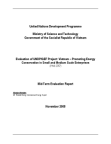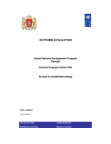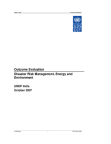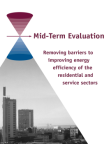The project development goal is to reduce the annual growth rate of GHG emissions through the removal of key barriers to the adoption of more energy efficient technologies and energy efficient practices in the Small and Medium Enterprises sector.To achieve this goal, the Project was designed with
UNDP
Report of the Outcome Evaluation on Energy (CPO-06)
The phenomenal economic growth and the world's largest national population of China and its extensive dependence on coal and petroleum have led to many critical and massive environmental effects.
Evaluation of The Role and Contribution of UNDP in Environment and Energy
The main purpose of this evaluation was to assess UNDP's positioning and contributions to managing environment and energy for sustainable development.
Access to sustainable energy improved through increased electricity production by using indigenous renewable energy resources, improved energy efficienct and the development of Georgia's Energy Corridor
In Georgia, the United Nations Development Program (UNDP) aims to provide a support role for the country, especially in the area of poverty alleviation, private sector development, fostering democratic governance and strengthening local government, conflict alleviation and
2008 Outcome Evaluation Report on the UNDP Energy for Sustainable Development
The environment problem in the Philippines is huge and has enormously grown for the last 40 years and ENR agencies and institutions are unable to cope.
Capacity Building for Stage II Adaptation to Climate Change in Central America, Mexico and Cuba
Capacity Building for Stage II Adaptation to Climate Change in Central America, Mexico and Cuba
Biomass Energy for Heating and Hot Water Supply
Since the 1990s, the Government of Belarus has recognized the importance of reducing its historically excessive dependence on energy imports from Russia and the need for action to strengthen its energy security.
Disaster Risk Management, Energy and Environment
Over the past few years, India's economic performance has been impressive, with a growth rate of 8% in 2005-2006. The boom is, however, placing increasing demands on natural and energy resources, with potentially serious consequences for the environment.
Removal of Barriers to Energy Efficiency and Improvements in the Steel Re-rolling Mill Sector in India
Steel re-rolling is one of the most important segments of the steel industry, as it constitutes an unavoidable link in the total supply chain of iron and steel. The secondary steel production constitutes approximately 57% of the total steel production in India.
Removing barriers to improving energy efficiency of the residential and service sectors
The objective of the project was to remove the key barriers to the implementation of economically feasible energy efficiency technologies and measures in the residential and service sectors, thereby reducing their energy consumption and associated greenhouse gas emissions.












